June 28, 1979
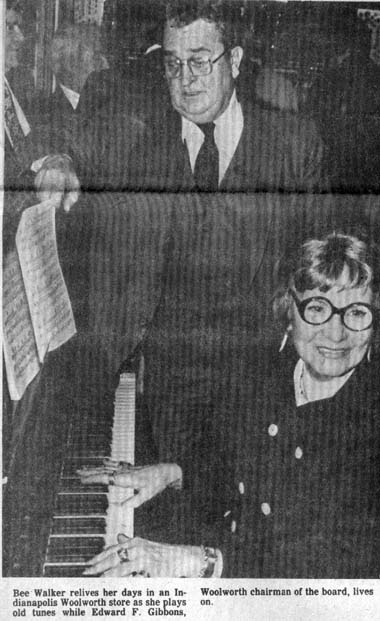
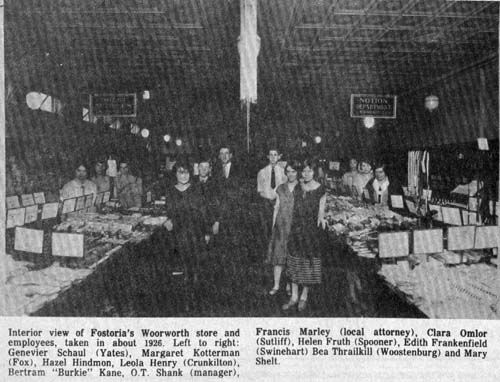
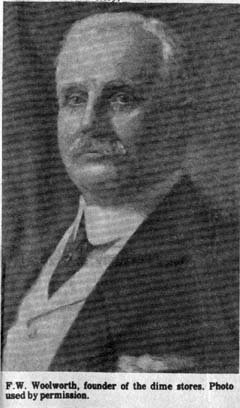
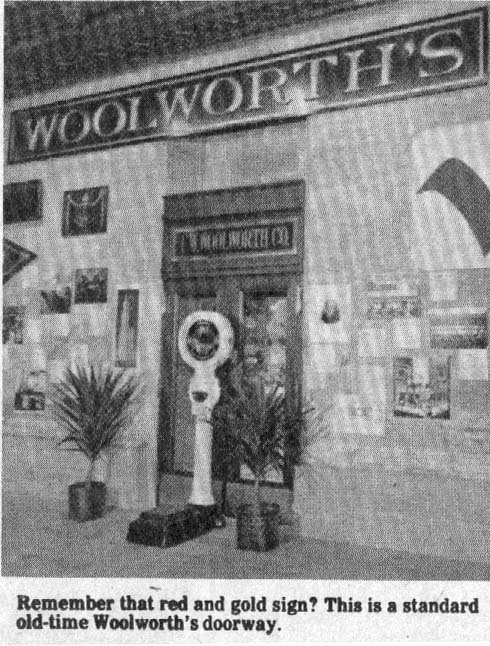
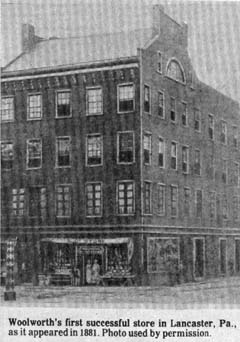
Picture #1 – Bee Walker, relives her days in an Indianapolis Woolworth store as she plays old tunes while Edward F. Gibbons, Woolworth chairman of the board, lives on.
Picture #2 – Interior view of Fostoria’s Woolworth store and employees, taken in about 1926. Left to right: Genevier Schaul (Yates), Margaret Lotterman (Fox), Hazel Hindmon, Leola Henry (Crunkilton), Betram “Burkie” Kane, O.T. Shank (manager), Francis Marley (local attorney), Clara Omlor (Sutliff), Helen Fruth (Spooner), Edith Frankenfield (Swinehart) Bea Thraikill (Woostenburg) and Mary Shelt.
Picture #3 – F.W. Woolworth of the dime stores. Photo used by permission.
Picture #4 – Remember that red and gold sign? This is a standard old-time Woolworth’s doorway
Picture #5 – Woolworth’s first successful store in Lancaster, Pa., as it appeared in 1881. Photo used by permission.
One hundred years ago a man by the name of Frank Winfield Woolworth started a store in Utica, N.Y., and called it the “Great Five Cent Store”. That was the beginning of what eventually became the F.W. Woolworth chain of stores that spread around the world and became more commonly known as the “Five Cent and Ten Cent Store”. Nothing sold for more than 10 cents.
This year, when F.W. Woolworth Co. is celebrating its 100th Anniversary it has significance for many Fostorians who remember the Woolworth Store here… even though it ceased to operate in 1956. It will be remembered as being located in the Botto Block, where the Family Store is now.
FOSTORIAN WENT FAR WITH WOOLWORTH’S
Further significance of the anniversary for some Fostorians is the fact that Dean C. Eger, who grew up here and became associated with Woolworth when a young man, made that his lifetime connection, and finally became executive buyer in their New York office. He retired in 1962.
While attending Fostoria High School, Eger started to work at the local Woolworth Store, before and after school, on Saturday and during vacations.
He recalls that each morning his first duty was to take a pail and go across Main Street to the “town pump” and get water for the employees to drink. That “town pump” was the one that stood near the curb in front of the Fakalos place of business and will be remembered by many readers. The pail of water was placed on a shelf in the basement of the store; a tin dipper hung on a nail near the pail for drinking purposes.
WOOLWORTH HAD MANY DIFFICULTIES AT START
Frank Winfield Woolworth had an exceedingly difficult time in his early life, a circumstance which probably contributed to his persistence and will to succeed. His first employers even thought he was not intelligent enough to wait on customers and he wound up washing windows, delivering, sweeping and doing other menial jobs. He even worked for a time without pay, just to get experience. Later he worked 15 hours a day for 50 cents…not 50 cents per hour, but 50 cents per day. Imagine that!
His early work experience brought on a nervous breakdown and he went home to his parents, near Watertown, N.Y., to be nursed back to health by his loving mother, who convinced him he would succeed and become rich some day.
When he was well again he borrowed $300 and opened a store of this own, in Watertown. Very simply, he laid his merchandise out on tables, pricing it at not more than 10 cents…much of it for five cents.
His first three stores failed, but on his fourth try he found the secret for merchandising, and he made $2.50 the first week. He opened 12 more stores that year and continued to grow into the nationwide chain…the first of its kind…and eventually worldwide.
The two secrets that spelled success for Woolworth were: the importance of a good location, and the need for a variety of merchandise.
FOSTORIA STORE STARTED IN 1916
When F.W. Woolworth Company decided to open a store in Fostoria it was 1916. The first manager was Ray V. Nicholson. Our town was booming. On Saturdays especially in the evening, it was difficult to get through the crowds that thronged the streets and stores. That might seem an exaggeration, but it is a fact. Everybody cam “uptown” on Saturday night.
Woolworth had a “good location” in Fostoria. It was the Botto Block one of the town’s newer buildings, at North and Main. Older Fostorians will remember the red sign, with the gold lettering “F.W. Woolworth Co.”…their standard identification. The one accompanying photo shows a typical store entrance of those days, with their sign and the scale, where you could weigh yourself for a penny.
Woolworth Co. had a year lease on the first floor of the Botto Block when they started in Fostoria…they expected to stay in business for a long time. But, initially they occupied only the north half of the first floor. A partition separated the first floor, and Zemer and Orwig Drug Store occupied the south room. As the business grew locally, they removed the partition and occupied the entire first floor.
FOSTORIANS REMEMBER LOCAL STORE
Older Fostorians will remember the variety of merchandise that was displayed on the counters in the local store…for not more than ten cents. There was a large candy counter, also ribbon, yarn, greeting cards, rugs, notions, hardware, muslin, stationery, woodenware, jewelry, records, paint, and much more. In fact, much of the same merchandise of today’s variety stores, but none of the appliances, rugs, furniture, etc. And, merchandise was displayed by much less sophisticated methods…and the prices much less.
The music department in some of the larger Woolworth stores, where sheet music was sold, was popular, because they had a piano and pianist, where songs of that era could be played for the customers to stimulate sales. One of the accompanying photos shows a reconstructed scene at a Woolworth reception in New York, commemorating their 100th anniversary. Bee Walker, who pounded out tunes for customers in the Woolworth store in the Indianapolis was discovered in New York recently and invited to play some of the old songs…such as “I Cried For You”, “Toot Toot Tootsie” and “Five Foot Two, Eyes of Blue”.
Those who especially remember the local store, the merchandise etc., are those former employees still living. Some still reside here. One of those is Dorothy (Kuhn) Vanderhoff, she worked there starting in the 1920’s, and who helped assemble the following list:
Shirley Good, Erline Reidling, Joan Haughawart, Betty Zeigler, Jim Harris, Ann Weiker, Barbara Conrad, Donna Musser, Sarah Martin, Neva Bomer, Cheri Lou Jackson, Pat Williams, Patty Russell, Janet Gillespie, Bonnie Mogart, Roger Ferguson, Jim McCarley, Doris Clark.
Audrey Watkins, Nellie Moyer, Vera Hoover, Maxine Wilcox, Richard Wilcox, Hattie Eckert, Leah Elkert, Lavonne Henline, Ruth Henline, Betty Davison, Vernie Stearns, Margaret Bentz, Thelma Racey, Mrs. Fouts, Margaret Koons, Geneview Schaull, Doris Roberts.
Madelin Rinehart, Pearl Herbert, Flossie Rigby, Beatrice Thrailkill, Maxine Warner, Helen (Fruth) Spooner, Helen (Leeseburt) cotter, Etta May (Kindmon) Wagner, Grace Frankfarther, William “Skeet” Boyd, Mary Arnoldi.
Mrs. Vanderhoff said some of the old employees got together a year ago to talk over “old times”.
MANAGERS MAY BE REMEMBERED
When Mrs. Vanderhoff went to work for Woolworth, H.C. Birch was manager, followed by M.D. Matthew. She worked after school and on Saturday until she was out of school, at which time she left, but returned to work in 1946 and stayed until 1955.
Helen (Fruth) Spooner also worked at the store, starting in about 1922, and for a number of years. She clerked and also supplied some of the names for the above list and the local photo. During her employment she said a Mr. Morris was manager for a short time.
Other managers in that period were C.W. Powers, 1924-25, O.T. Shank, 1926-29; H.L. Bretzius, 1930-36; T.N. Sunshine, 1938-40.
Robert Hiebet was manager of the Fostoria store when World War II erupted in 1941. L.G. Wilsman followed in 1942. Then, during the war period, when most mangers were drafted into service, some of the more experienced clerks and floor walkers substituted as managers. In Fostoria, Ruby Boon and Martha Eckert filled the manager slot until William J. “Bill” Williams arrived in 1946 after getting out of the army. He was previously at the Bellefontaine store. He stayed until 1950, and was succeeded by Ed Stikes, followed by W. C. Jewels in 1953, and Charles Harr in 1955, after which time the store closed in 1956.
RATS PRODUCED FEAR AND LAUGH
Every situation has a comical story. One of those connected with this story, and told by Dorothy Vanderhoff, was during the period when Williams was manager.
“The stockroom in the basement had many big rats…and needless to say the girls were continually frightened by them. At closing time one day Audrey Watkins was in the basement, unbeknownst to Williams. He started closing up and turned out the basement lights. Then he and I heard a terrifying scream. It seemed to come from the basement. He hurriedly turned on the lights and opened the basement door. Up dashed Audrey, nearly frantic with fear. She had visions of being locked down there for the night…with the rats and their eyes gleaming in the dark”.
Be sure and watch for the profile story next week about Dean Eger.